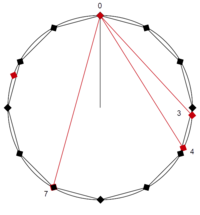
The β (beta) scale is a non-octave-repeating musical scale invented by Wendy Carlos and first used on her album Beauty in the Beast (1986). It is derived from approximating just intervals using multiples of a single interval without, as is standard in equal temperaments, requiring an octave (2:1). It may be approximated by splitting the perfect fifth (3:2) into eleven equal parts [(3:2)1⁄11 ≈ 63.8 cents]. It may be approximated by splitting the perfect fourth (4:3) into two equal parts [(4:3)1⁄2],[1] or eight equal parts [(4:3)1⁄8 = 64 cents],[2] totaling approximately 18.8 steps per octave.
The scale step may also precisely be derived from using 11:6 (B↑♭-, 1049.36 cents, ) to approximate the interval 3:2⁄5:4,[3] which equals 6:5 .
In order to make the approximation as good as possible we minimize the mean square deviation. ... We choose a value of the scale degree so that eleven of them approximate a 3:2 perfect fifth, six of them approximate a 5:4 major third, and five of them approximate a 6:5 minor third.[3]
and ()
Although neither has an octave, one advantage to the beta scale over the alpha scale is that 15 steps, 957.494 cents, is a reasonable approximation to the seventh harmonic (7:4, 968.826 cents)[3][4] though both have nice triads[1] (, , and ). "According to Carlos, beta has almost the same properties as the alpha scale, except that the sevenths are slightly more in tune."[1]
The delta scale may be regarded as the beta scale's reciprocal since it is "as far 'down' the (0 3 6 9) circle from α as β is 'up'."[5]
| interval name | size (steps) |
size (cents) |
just ratio | just (cents) |
error |
| major second | 3 | 191.50 | 9:8 | 203.91 | −12.41 |
| minor third | 5 | 319.16 | 6:5 | 315.64 | +3.52 |
| major third | 6 | 383.00 | 5:4 | 386.31 | −3.32 |
| perfect fifth | 11 | 702.16 | 3:2 | 701.96 | +0.21 |
| harmonic seventh | 15 | 957.49 | 7:4 | 968.83 | −11.33 |
| octave | 18 | 1148.99 | 2:1 | 1200.00 | −51.01 |
| octave | 19 | 1212.83 | 2:1 | 1200.00 | +12.83 |
See also
[edit]References
[edit]- ^ a b c Milano, Dominic (November 1986). "A Many-Colored Jungle of Exotic Tunings", Keyboard.
- ^ Carlos, Wendy (2000/1986). "Liner notes", Beauty in the Beast. ESD 81552.
- ^ a b c Benson, Dave (2006). Music: A Mathematical Offering, p.232-233. ISBN 0-521-85387-7. "Carlos has 18.809 β-scale degrees to the octave, corresponding to a scale degree of 63.8 cents."
- ^ Sethares, William (2004). Tuning, Timbre, Spectrum, Scale, p.60. ISBN 1-85233-797-4. Scale step of 63.8 cents.
- ^ Taruskin, Richard (1996). Stravinsky and the Russian Traditions: A Biography of the Works through Mavra, p.1394. ISBN 0-520-07099-2.
External links
[edit]- Carlos, Wendy (1989–96). "Three Asymmetric Divisions of the Octave", WendyCarlos.com.





Well, that’s interesting to know that Psilotum nudum are known as whisk ferns. Psilotum nudum is the commoner species of the two. While the P. flaccidum is a rare species and is found in the tropical islands. Both the species are usually epiphytic in habit and grow upon tree ferns. These species may also be terrestrial and grow in humus or in the crevices of the rocks.
View the detailed Guide of Psilotum nudum: Detailed Study Of Psilotum Nudum (Whisk Fern), Classification, Anatomy, Reproduction